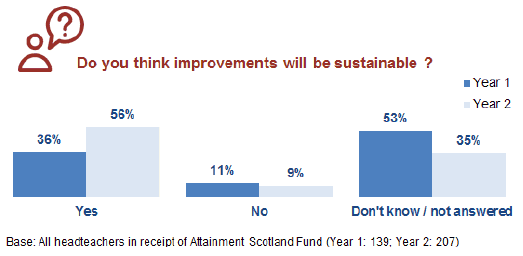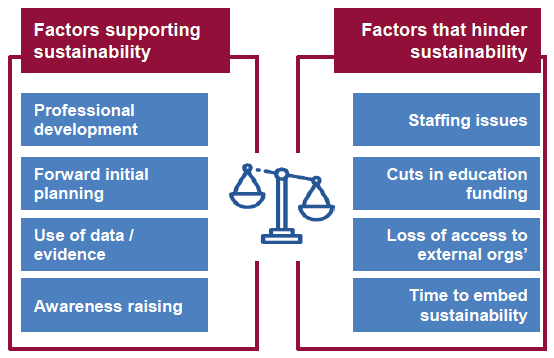Attainment Scotland Fund evaluation: interim report (years 1 and 2)
The evaluation aims to provide learning about the overall implementation of the Attainment Scotland Fund over its first two years.
10. Sustainability
10.1. This chapter explores the extent to which stakeholders believed the impact of the Attainment Scotland Fund could be sustained beyond the years of funding. Specifically, it explores two key questions:
- To what extent can interventions continue to exist beyond the years of funding?
- To what extent can progress achieved by the interventions be maintained beyond the years of funding?
Chapter Highlights – Sustainability
- Whilst stakeholders were positive about the sustainability of the impact of the fund, they also expressed some reasons to be cautious.
- Confidence in the sustainability of improvement in the poverty related attainment gap increased from Year 1 to Year 2.
- Overall, confidence in sustainability seemed to be linked to a belief that the fund had created significant change in practice and culture. Improved teaching, leadership and data skills and an increased awareness of the impact of poverty on attainment were all acknowledged to have long lasting impact.
- There was widespread belief that interventions or approaches relying on additional resources would not be sustainable without funding.
- Sustaining improvement within the context of local cuts and possible withdrawal of posts after the funding was a key challenge.
To what extent can interventions continue to exist beyond the years of funding?
10.2. Overall, there was some evidence of confidence that the interventions implemented as a result of the Attainment Scotland Fund would continue to exist beyond the years of funding. This was specifically the case amongst teachers and Challenge Authorities.
- In the qualitative research, most teachers interviewed said that they thought their work would be sustainable.
- Challenge Authorities were also confident about the sustainability of their approaches. They mentioned that their strategic plans were designed to ensure long term sustainability.
10.3. Information about the sustainability of interventions was gained from interviews with teachers, local authorities and attainment advisors who took part in the qualitative research. Responses to the headteacher survey also provided evidence about the perceived sustainability of the interventions.
10.4. This section describes the interventions that were perceived as most likely to continue and those that were perceived as least likely to continue without ongoing support from the Attainment Scotland Fund. It explains in detail what was seen as favouring and hindering sustainability as shown in Figure 10.1.
Figure 10.1: Interventions that favour and
hinder sustainability

Sustainable interventions
10.5. Interventions which produced a wider shift in culture, ethos or practice were perceived as those most likely to continue beyond the years of the fund.
10.6. Teachers interviewed in the qualitative research mentioned that approaches for improving Literacy, Numeracy and Health and Wellbeing developed through the Attainment Scotland Fund would continue to be used.
10.7. Whilst there was limited evidence overall about the specific interventions that were more likely to be sustainable, the evidence suggested that it was the legacy of the approach that would have long lasting impact. For example, the up-skilling of teachers through training provided as a result of the funding would have long term benefits. This is discussed in more detail in the second section of this chapter.
Unsustainable interventions
10.8. Interventions requiring additional staff were noted as approaches which would not be sustainable. Some of the teachers interviewed in the qualitative research mentioned that smaller class sizes, group work and specialist support ( e.g. counsellors) all had a significant impact on closing the attainment gap yet were least likely to be sustained beyond the years of the Attainment Scotland Fund.
10.9. Teachers in the qualitative research and responses to the headteacher survey highlighted a concern that collaborative work with third sector organisations would be difficult to continue when funding ceased.
10.10. Attainment Advisors interviewed in the qualitative research similarly mentioned that interventions reliant on additional funding were less likely to be sustainable.
10.11. Attainment Advisors also felt that some interventions that had particular scope for producing long term benefits would be difficult to maintain without some form of ongoing support.
To what extent can progress achieved by the interventions be maintained beyond the years of funding?
10.12. Overall, there were mixed views on the potential sustainability of improvement in the poverty related attainment gap beyond the life of the fund. Whilst there was widespread confidence that improvement could be maintained, there was also widespread doubt about this.
10.13. Positively, however, confidence in the sustainability of progress increased over time, from the first to the second year.
10.14. Data was collected from the headteacher survey, the local authority mini-survey, progress reports and in-depth interviews with key stakeholders involved in the qualitative research.
10.15. This section of the report begins by describing how key stakeholders viewed the sustainability of improvements before going on to discuss what factors supported or hindered sustained progress.
Sustainability of improvements
10.16. Overall, the evidence suggested that both schools and local authorities were reasonably confident that improvements would be sustainable. Confidence in the sustainability of improvements increased amongst headteachers from the first to the second year of the fund.
Figure 10.2: Sustainability of improvements,
headteacher survey

10.17. Confidence in the sustainability of improvement in the poverty related attainment gap increased from 36% in Year 1 to 56% in Year 2. There was some uncertainty as to whether improvements will be sustainable, though this decreased over time. Around half (49%) in Year 1 and under a third (31%) in Year 2 were unsure about the sustainability of the improvements achieved.
10.18. Similarly, in Year 1, all seven Challenge Authorities responding to the local authority mini survey reported that they thought the improvements would be sustainable beyond the years of funding.
10.19. Evidence was also collected on factors that could potentially support and hinder sustainability. Figure 10.3 depicts a summary of key findings and the paragraphs that follow provide further detail.
Figure 10.3: Key factors that support and
hinder sustainability

Sustainability of improvements – Successes
10.20. Overall, schools and local authorities believed in the sustainability of their improvements for a number of reasons. These included:
- The long-lasting impact of professional development.
- Improved approach to the use of data
- Raising awareness about the impact of poverty.
- Sustainability had been a key part of initial planning.
10.21. One of the most common reasons across all data sources for expecting improvements to be sustainable was due to the impact of professional development.
10.22. Specifically, training that involved the development of data, leadership, teaching or self-evaluation skills were believed to have a positive impact on preserving progress. Overall, headteachers seem to see skills which allow for more effective governance of the schools as those with the most decisive impact on sustainability.
10.23. In addition, the change in practice, including increased collaboration and professional dialogue, brought about as a result of the fund was believed to be sustainable after funding ceased. For example, in Year 2 of the headteacher survey, 16% of headteachers explicitly mentioned increased collaboration as a long-lasting consequence of the fund and respondents indicated that there was likely to be a continued enthusiasm for partnerships with parents, third sector and other schools.
10.24. There was also a belief that the use of data to underpin the Attainment Scotland work would support sustainability. Teachers interviewed in the qualitative research, who were positive about the ability to maintain progress, felt this partly because there had been an improvement in the use of data. Local authority progress reports and responses to the headteacher survey also suggested that using evidence was a key part of sustained improvement.
10.25. More specifically, headteachers participating in Year 2 of the survey suggested that successful use of data improves the ability of the school to reshape its practice based on evidence, and improves the awareness of the teachers by making them realise the impact that poverty has on the pupils at their schools.
10.26. Across all data sources, there was evidence that confidence in sustainability was linked to an increased awareness and understanding of the attainment gap. In Year 2 of the headteacher survey, nearly a third of those who said their improvements were sustainable indicated that this was due to an improved understanding of inequality.
10.27. Those who believed in the sustainability of improvements also seemed to have made efforts to embed the commitments of the Attainment Challenge into their long term planning approach. Progress reports indicated that local authorities were strongly committed to achieving sustainability.
10.28. Headteachers responding to the online survey in Year 1 also mentioned that sustainability had been built into their local planning. However, only a few headteachers in Year 2 of the survey explicitly mentioned embedding sustainability into strategic planning. Instead, they emphasised their investment in teachers' self-development with an understanding that staff who participated in implementing the fund can continue to use their expertise successfully even beyond the years of the funding.
10.29. Those responding to the local authority survey mentioned a commitment to continue posts created as part of the Attainment Challenge beyond the years of the fund. However, the uncertainty surrounding the continuation of these posts remained a concern for headteachers, as shown in the next section.
Sustainability of improvements – Challenges
10.30. Whilst there was widespread confidence that improvements would be maintained beyond the years of the fund, stakeholders expressed some reasons to be cautious about sustainability.
10.31. For headteachers and local authorities who were unsure about the sustainability of improvements, the following reasons were mentioned and these are discussed in more detail below:
- Staffing levels
- Local cuts in education funding
- Poverty and other systemic issues with a negative impact on the local communities.
- Time to embed sustainability
10.32. In Year 1 and 2 of the headteacher survey, the potential withdrawal of posts or reduction in staffing levels after the Attainment Scotland Fund was the most common reason reported for being concerned about the long term sustainability of progress.
10.33. In Year 2 of the survey, 55% of headteachers indicated that any reduction of staff was a challenge to sustainability. More specifically, they reported that staff reductions would have detrimental consequences on opportunities to attend training, motivation of staff and the impact of leadership roles.
10.34. Qualitative interviews with authorities showed that authorities felt that funded posts had been critical in creating change and therefore if these posts were discontinued when funding ceased then this would impact negatively on the progress made.
10.35. Teachers interviewed in the qualitative research and those responding to the headteacher survey discussed the challenges of sustainability within the context of cuts in education funding, and cuts to wider support services. While this was a prominent theme in Year 1 of the headteacher survey, in Year 2 it was only mentioned by 7% of respondents.
10.36. Recognition that the poverty related attainment gap was influenced by wider factors outside of education was another reason for being unsure whether improvements would be sustainable. Teachers and local authorities emphasised that education alone was not sufficient to ensure sustainable change. In Year 2, 13% of headteachers participating in the online survey focused on the wider issues within the community such as poverty, unaddressed mental health problems, addiction, and insufficient parental engagement
10.37. Finally, local authorities responding to the online survey said that it would take time to create any real sustained impact from the work of the Attainment Scotland Fund. Therefore, whilst progress may have been achieved, it would still take time to embed the progress and sustain it long term.
Contact
Learning Analysis: socialresearch@gov.scot
There is a problem
Thanks for your feedback